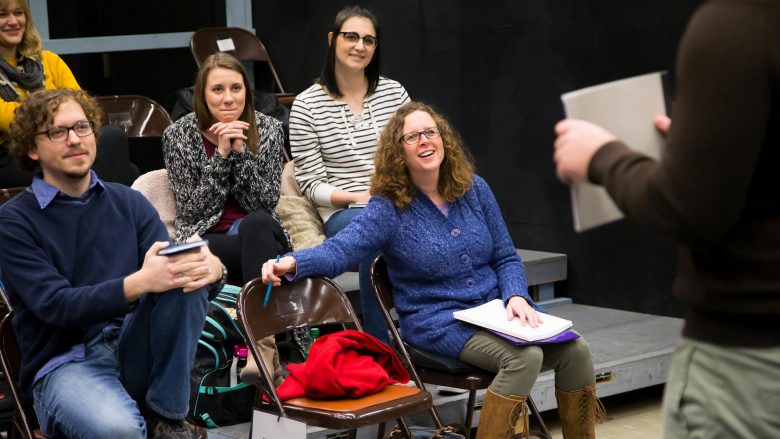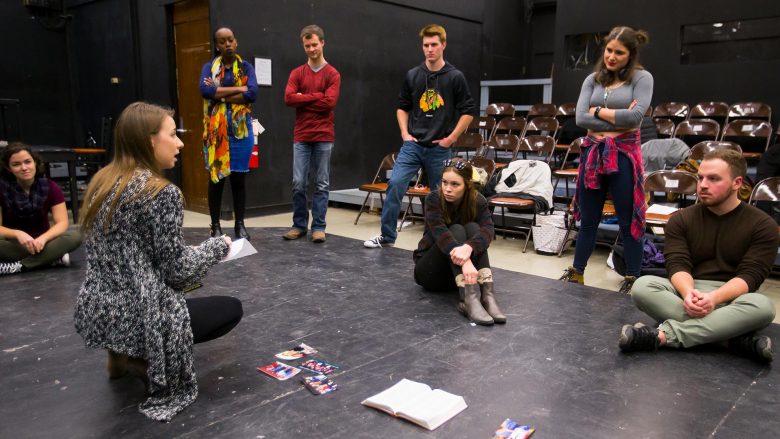Between the lines
“Imagine you’re making a pie,” Dr. Telory Arendell says. “You make the crust, put the filling inside and put the crust on top. Then you go around the top and shave off the part that’s extra, the part you don’t need.”
But why do you think you don’t need it? Maybe only because you’ve been told it’s not part of the pie.
“For me, that ‘extra’ is what’s actually most important, even though many people would throw it away,” Arendell says. And she isn’t really talking about pie.
Arendell, associate professor in the department of theatre and dance, uses this metaphor to describe her favorite theatrical experiences – moments that surprise the audience because they don’t quite fit our expectations of a night at the theater.
“When I write about movement on stage, I try to recreate the action with words that dance.” — Dr. Telory Arendell
“Performance art, experimental theater, what was called ‘happenings’ back in the ’60s,” Arendell says. “I love that stuff.”
Audiences sometimes worry that without the familiar rhythms of the theater, without clear heroes and villains and the promise of a resolution by final curtain, it will be hard to understand what’s happening on stage.
But, Arendell says, “You understand it in a different way. Sometimes you know fully that what’s most important isn’t what’s being said, but what’s happening between the lines. That’s my space: what happens between the lines.”
Arendell draws inspiration from experimental artists like German choreographer Pina Bausch, who is the subject of her next book.
“Pina Bausch was wild,” Arendell says. “She took highly technically trained dancers and put them on stage and had them do movement, such as stumbling, that wasn’t technical at all.”
And, according to Arendell, subverting the audience’s expectations was the point. “She was so conscious of what was expected, and then put up something completely different. It was a critique of what people like to call ‘high art.’”

Photo by Bob Linder
Beyond the ordinary
In many ways, performances that don’t conform to expectations connect with another of Arendell’s research areas: disability studies.
Someone who is living with a disability may experience the minutiae of day-to-day life in ways that are profoundly different from the majority of the population. When performers are free to venture outside expected theatrical norms, they can shift the perspective of audience members who don’t have personal experiences of disability.
Arendell has explored this connection in two books: “Performing Disability: Staging the Actual” and “The Autistic Stage: How Cognitive Disability Changed 20th Century Performance.” Her perspective is grounded in the idea that disability should be viewed as a “facilitating rather than a debilitating experience.”
As she puts it in her writing: “We become richer each time we come to understand these new perspectives, and performance powerfully enables our understanding of them.”
“Even off the stage, in life, people move in space in ways that tell stories. It’s a message that’s communicated with the body.” — Dr. Telory Arendell
For example, imagine watching a play you’ve seen before. But this time, it’s in a language you don’t understand. You could rely on your memory of the story, gleaning additional meaning from performers’ body language and tone. This is not unlike the way someone with nonverbal autism might piece together information that’s delivered through words they find incomprehensible.
Or, another example: imagine a performance where actors contend with props, sets and furniture that are either much too small or much too large – all while trying to perform the play as it was written. This might offer a glimpse of how someone with a physical disability navigates spaces that were designed with only one type of physicality in mind.
And these are just a few instances of how experimental performances, the “wild stuff” Arendell loves, provide opportunities to broaden perspectives. Theater, she believes, is an ideal place to showcase disability as something other than a deficit. It can instead be considered an “extraordinary experience.” Literally, “beyond the ordinary.”
In “Autistic Stage” she writes, “My own work explores how the performing arts have embraced autism as a set of new perspectives that change the way audiences conceive of space, time, personhood, embodiment, communication, and stage or film imagery.”

Photo by Bob Linder
Outside categories
Arendell brings this research into her teaching. In addition to working closely with the disability studies program, she challenges her theater students to think about their work in radically different ways.
“My class ‘Scripting and Performing’ brings in students who have never done performance art or experimental work,” she says. It offers them the chance to re-envision the scope of their talents.
Returning to the pie metaphor, Arendell says, “Their impulse is to scrape along the edges of the pie tin. I pick up the edges that are set to be thrown away and say, ‘This is the heart of what you’re doing. This is where your story lies, where you’re not trying to fix yourself so you’ll fit into an established category.’ I say, ’This can be your category.’”
- Story by Lucie Amberg
- Main photo by Bob Linder
- Video by Lucie Amberg


I loved both the video and your words, Telory. I’m proud of what you have done and are doing. Proud to be your aunt. Love, Betty Jo